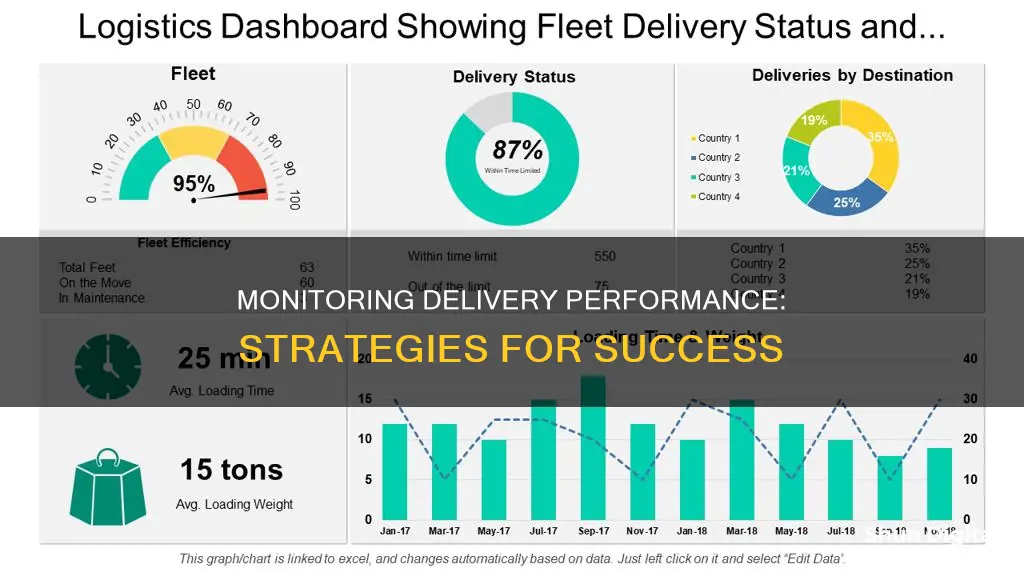
Monitoring delivery performance is crucial for businesses to meet customer expectations and ensure timely, accurate deliveries. It involves tracking key performance indicators (KPIs) and metrics to evaluate the efficiency and effectiveness of delivery operations. By analysing delivery performance, businesses can identify areas for improvement, optimise resources, and enhance customer satisfaction. This process includes defining delivery standards, setting up a tracking system, choosing relevant metrics, and acting on the data to improve overall delivery performance.
| Characteristics | Values |
|---|---|
| Definition | Delivery performance is an organisation's ability to supply goods and services according to customer expectations and standards. |
| Purpose | To improve customer service, reduce costs and optimise operations. |
| Delivery standards | Delivery time, delivery window, delivery accuracy, and delivery condition. |
| Tracking system | Barcode scanners, RFID tags, GPS trackers, delivery notes, invoices, receipts, spreadsheets, databases, software, dashboards, reports, charts. |
| Metrics | On-time delivery rate, fill rate, damage rate, delivery cost, and delivery satisfaction. |
| Analysis | Trend analysis, variance analysis, root cause analysis, action plan development and implementation. |
| Tools | Shipping status tools, order processing tools, lean inventory platforms, warehouse management, bidding and spending analysis, analytics and reporting, collaboration portals, transportation and logistics management, compliance and auditing. |
| Factors | Route optimisation, vehicle maintenance, inventory management, external factors, communication and coordination, supply chain management, inventory management, transportation requirements. |
| KPIs | Number of completed deliveries, order accuracy, first attempt delivery rate, on-time delivery rate, average time per delivery, average cost per delivery, out-of-route miles, vehicle capacity utilisation, net promoter score. |
What You'll Learn

Define delivery standards
Before you can track and monitor your delivery performance, you need to define clear delivery standards. These criteria measure how well you are delivering your products to your customers. Delivery standards may vary depending on the product, customer, or region.
Common delivery standards include:
- Delivery time (from order confirmation to delivery confirmation)
- Delivery window (the range of time within which the delivery is expected to arrive)
- Delivery accuracy (how closely the delivered quantity and quality match the ordered quantity and quality)
- Delivery condition (how well the delivered products preserve their freshness, safety, and integrity)
It is important to communicate your delivery standards to your customers and ensure that they are realistic, achievable, and aligned with your business goals.
Once you have defined your delivery standards, you can set up a delivery performance tracking system to collect, store, and organise data related to your deliveries. Various tools and methods can be used for this, such as barcode scanners, RFID tags, GPS trackers, delivery notes, invoices, and receipts. Additionally, dashboards, reports, and charts can be used to display and summarise the delivery data visually.
When defining your delivery standards, it is crucial to consider the factors that can impact delivery performance. These include:
- Route optimisation: Inefficient route planning can lead to longer delivery times and increased fuel costs.
- Vehicle maintenance: Reliable delivery vehicles are essential for on-time deliveries and preventing unexpected breakdowns.
- Inventory management: Accurate inventory data ensures successful deliveries and prevents delays due to stockouts or errors in fulfilment.
- External factors: Weather conditions, road closures, traffic congestion, or unforeseen events can disrupt delivery schedules.
- Communication and coordination: Effective communication between drivers, dispatchers, and customers is vital for accurate and timely deliveries.
Fortigate Bandwidth Monitoring: Security, Performance, and Cost Savings
You may want to see also

Set up a tracking system
To set up a tracking system for monitoring delivery performance, you should first define your delivery standards. These criteria measure how well you are delivering your products to customers. Common delivery standards include delivery time, delivery window, delivery accuracy, and delivery condition. It is important to communicate these standards to your customers and ensure they are realistic, achievable, and aligned with your business goals.
Once you have defined your delivery standards, you can set up a delivery performance tracking system to collect, store, and organise data related to your deliveries. Various tools and methods can be used, such as barcode scanners, RFID tags, GPS trackers, delivery notes, invoices, receipts, spreadsheets, databases, software, or other platforms. Additionally, dashboards, reports, charts, or other formats can be used to display and summarise the delivery data visually. Choose the tools and methods that suit your budget, resources, and needs, ensuring that your system is accurate, reliable, and secure.
- Barcode scanners and RFID tags can be used to track and manage inventory levels, ensuring that products are available for delivery and reducing stockouts.
- GPS trackers can provide real-time location data for deliveries, helping to monitor delivery routes, estimate arrival times, and identify any delays or deviations from the planned route.
- Delivery notes, invoices, and receipts can be digitised and stored in a central database or platform, ensuring easy access and retrieval of delivery information.
- Spreadsheets and databases can be used to organise and analyse delivery data, such as delivery times, costs, and customer feedback.
- Software solutions, such as delivery management software or transportation management software, can automate and streamline the delivery process, providing real-time updates and improving efficiency.
LCD Monitors at Madison Square Garden: A Technical Upgrade
You may want to see also

Choose delivery performance metrics
After setting up a delivery performance tracking system, the next step is to choose the delivery performance metrics. These metrics are indicators that evaluate how well your business is meeting its delivery standards.
- On-time delivery rate: This metric tracks the percentage of orders fulfilled within the expected delivery date. It is a crucial KPI as it improves customer experience and retention.
- Number of completed deliveries: This refers to the total number of successful deliveries within a specific time frame. This metric helps determine the overall effectiveness of delivery performance and can be used to calculate the average number of deliveries, aiding in identifying growth potential.
- Order accuracy: Also known as the perfect order measurement, this is the percentage of orders delivered without errors compared to the total number of orders. It helps to spot mistakes during the delivery process, such as returned or damaged products.
- First Attempt Delivery Rate (FADR): This metric measures the percentage of deliveries successfully completed on the initial attempt without the need for re-deliveries. A high FADR signifies an efficient delivery process that saves time, resources, and enhances customer satisfaction.
- Average time per delivery: This metric refers to the average time required to complete a delivery over a specific period. It helps determine the efficiency of planned delivery routes and the overall effectiveness of the supply chain.
- Average cost per delivery: This metric calculates the average expenses incurred to fulfil each delivery, including fuel costs, labour, maintenance, and vehicle depreciation. By understanding the cost components, businesses can make informed decisions about resource allocation and cost management.
- Vehicle capacity utilisation: This metric compares the capacity of a delivery vehicle that is used to its total capacity. By calculating the available capacity against the total capacity, businesses can identify inefficiencies in the loading process or opportunities to merge delivery routes.
- Customer satisfaction: While not directly tied to the delivery process, customer satisfaction is a crucial metric. A high Net Promoter Score (NPS) indicates satisfied customers who are likely to become repeat buyers and enthusiastic advocates for your brand.
It is important to select metrics that are relevant, meaningful, and actionable for your business. Additionally, setting targets or benchmarks for each metric allows for a comparison between actual performance and desired performance.
Setting Up Your ASUS Monitor for CS:GO: A Step-by-Step Guide
You may want to see also

Analyze and act on data
Analyzing and acting on your delivery performance data is essential to improving your customer service, reducing costs, and optimizing operations. This process involves identifying your strengths, weaknesses, opportunities, and threats in the delivery process.
- Trend Analysis: Compare your delivery performance over time to spot patterns, changes, or anomalies. For example, you can compare this month's delivery performance to last month's to identify any improvements or areas that need attention.
- Variance Analysis: Compare your delivery performance against targets or benchmarks to identify gaps, deviations, or errors. For instance, if your target is to have 95% of deliveries made on time, you can use variance analysis to see if you're meeting that goal.
- Root Cause Analysis: Find the underlying reasons for any delivery performance issues. For example, if there are frequent delays, root cause analysis can help you determine if the cause is inefficient routing, vehicle maintenance issues, or something else.
- Action Plan Development: Based on your analyses, develop and implement an action plan to address any challenges or opportunities. For example, if root cause analysis reveals that inefficient routing is causing delays, your action plan may involve optimizing delivery routes using advanced routing software.
- Monitoring and Evaluation: Regularly monitor and evaluate the results and impacts of your actions. For instance, if you implemented route optimization, you can track delivery times to see if the changes have led to improvements. Make adjustments as needed to ensure continuous improvement.
By analyzing and acting on your delivery performance data, you can make informed decisions, streamline processes, and optimize resources. This will enable you to fine-tune your services to meet and exceed customer expectations.
Connecting Xbox to a Monitor Without HDMI: Alternative Methods
You may want to see also

Improve customer satisfaction
Customer satisfaction is a critical aspect of delivery performance and can be enhanced by meeting customer expectations in terms of timely and accurate deliveries. Here are some strategies to improve customer satisfaction:
- Set realistic delivery standards: Define clear and realistic delivery standards that align with your business goals and communicate them to your customers. These criteria should include delivery time, delivery window, delivery accuracy, and delivery condition.
- Utilise delivery performance tracking systems: Implement tools such as barcode scanners, RFID tags, GPS trackers, and delivery management software to collect, store, and organise data related to your deliveries. This enables you to monitor and improve your delivery performance.
- Choose relevant delivery performance metrics: Select metrics that are meaningful and actionable for your business, such as on-time delivery rate, fill rate, damage rate, delivery cost, and delivery satisfaction. Set targets or benchmarks for each metric to evaluate your performance.
- Analyse and act on data: Use trend analysis, variance analysis, and root cause analysis to identify strengths, weaknesses, opportunities, and threats in your delivery process. Develop and implement action plans to address any challenges and regularly monitor and evaluate the results.
- Enhance customer experience with technology: Utilise GPS tracking systems and online temperature measurements to provide customers with real-time updates on their orders, improving their overall experience.
- Collect and act on customer feedback: Gather feedback after each delivery to analyse customer satisfaction and identify areas for improvement. This feedback loop allows you to make data-driven decisions and enhance your delivery services.
- Focus on on-time and accurate deliveries: Prioritise delivering orders within the agreed timeframe and ensure order accuracy. This builds trust and loyalty among customers, leading to repeat business and positive word-of-mouth referrals.
- Streamline operations: Optimise your delivery routes, minimise travel time, and reduce the chances of delays. Efficient operations not only improve customer satisfaction but also help reduce operational costs.
- Provide transparent delivery information: Share delivery status updates with customers, including estimated arrival times, to manage their expectations effectively.
- Build a customer-centric culture: Foster a company culture that prioritises customer satisfaction. Empower your employees to make decisions that enhance the customer experience and encourage them to go above and beyond to exceed customer expectations.
Adjusting Your ASUS Monitor: Raising It to New Heights
You may want to see also
Frequently asked questions
Delivery performance is an organisation's ability to supply goods and services as per the standards expected by its customers. It reflects the potential of the firm to meet customer expectations concerning time and cost.
KPIs for delivery performance include:
- Order fulfilment rates
- Lead time
- Stock-outs
- Customer satisfaction
- Market share
- Brand equity
- Transit time to distance
- Vehicle capacity utilisation
To measure delivery performance, you need to:
- Define your delivery standards
- Set up a delivery performance tracking system
- Choose your delivery performance metrics, such as on-time delivery rate and delivery cost
- Regularly analyse and act on your delivery performance data







